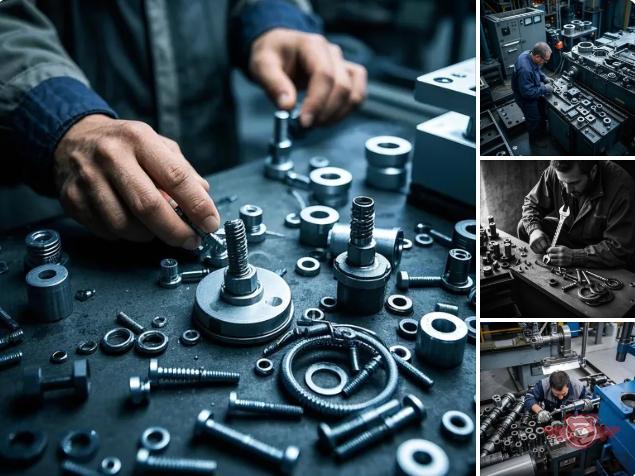Fasteners are the unsung heroes of construction, manufacturing, and engineering projects. However, even small mistakes in their selection, installation, or maintenance can lead to significant issues, including structural failures, safety hazards, and costly repairs. This article explores the most common fastener mistakes, their potential consequences, and actionable solutions to avoid them.

1. Incorrect Fastener Selection
Choosing the wrong fastener for a specific application is one of the most frequent mistakes. This can result in poor performance, premature failure, or even catastrophic accidents.
Common Errors:
-
Mismatched Materials: Using carbon steel fasteners in corrosive environments (e.g., marine or chemical industries) can lead to rust and failure.
-
Incorrect Size or Strength: Undersized or low-strength fasteners may not withstand the required loads, causing joints to fail under stress.
-
Ignoring Environmental Factors: Failing to account for temperature fluctuations, moisture, or chemical exposure can compromise fastener performance.
How to Avoid:
-
Match Materials to Conditions: Use stainless steel, titanium, or coated fasteners for corrosive environments.
-
Verify Load Requirements: Select fasteners with the appropriate tensile strength, shear strength, and load capacity for the application.
-
Consult Standards: Refer to DIN, ANSI, or ISO standards to ensure compliance with industry requirements.
For example, in outdoor construction, using galvanized or stainless steel fasteners prevents rust and ensures long-term durability.
2. Improper Installation Techniques
Even the best fasteners can fail if installed incorrectly. Improper installation can lead to loosening, fatigue, or structural damage.
Common Errors:
-
Over-Tightening: Excessive torque can strip threads, deform materials, or cause stress fractures.
-
Under-Tightening: Insufficient torque can result in loose connections, leading to vibrations and eventual failure.
-
Misalignment: Installing fasteners at an angle or in misaligned holes can weaken the joint and cause uneven load distribution.
How to Avoid:
-
Use Torque Tools: Employ torque wrenches or calibrated tools to achieve the correct tightening force.
-
Follow Manufacturer Guidelines: Adhere to recommended torque values and installation procedures.
-
Check Alignment: Ensure holes are properly aligned before installing fasteners.
In automotive assembly, for instance, using torque wrenches ensures that engine components are securely fastened without damaging threads.
3. Neglecting Maintenance and Inspections
Fasteners are often overlooked during routine maintenance, which can lead to undetected issues and unexpected failures.
Common Errors:
-
Ignoring Corrosion: Rust and corrosion can weaken fasteners over time, especially in harsh environments.
-
Failing to Retighten: Vibrations and dynamic loads can cause fasteners to loosen, requiring periodic retightening.
-
Skipping Inspections: Lack of regular inspections can result in unnoticed wear, fatigue, or damage.
How to Avoid:
-
Schedule Regular Inspections: Implement a maintenance plan to check fasteners for signs of wear, corrosion, or loosening.
-
Use Protective Coatings: Apply anti-corrosion coatings or replace fasteners with corrosion-resistant materials.
-
Monitor Vibration-Prone Areas: Pay special attention to fasteners in machinery or structures exposed to vibrations.
For example, in wind turbine maintenance, regular inspections and retightening of bolts prevent failures caused by constant vibrations and environmental stress.
4. Overlooking Compatibility Issues
Using incompatible fasteners or materials can lead to galvanic corrosion, chemical reactions, or mechanical failures.
Common Errors:
-
Galvanic Corrosion: Pairing dissimilar metals (e.g., aluminum and steel) without proper insulation can cause electrochemical reactions.
-
Chemical Incompatibility: Using fasteners that react with surrounding chemicals or coatings can degrade performance.
-
Mismatched Threads: Combining fasteners with incompatible thread types or pitches can result in poor connections.
How to Avoid:
-
Use Insulating Materials: Separate dissimilar metals with washers or insulating coatings to prevent galvanic corrosion.
-
Verify Chemical Resistance: Ensure fasteners are compatible with the chemicals or coatings in their environment.
-
Match Thread Specifications: Use fasteners with matching thread types and pitches for secure connections.
In the aerospace industry, for instance, titanium fasteners are often paired with composite materials to avoid galvanic corrosion and ensure compatibility.
5. Ignoring Industry Standards and Best Practices
Failing to adhere to industry standards can result in non-compliance, safety risks, and project delays.
Common Errors:
-
Non-Compliance with Standards: Using fasteners that do not meet DIN, ANSI, or ISO standards can compromise quality and safety.
-
Improper Documentation: Lack of proper documentation or certification for fasteners can lead to regulatory issues.
-
Ignoring Best Practices: Overlooking established installation or maintenance practices can increase the risk of failure.
How to Avoid:
-
Follow Standards: Use fasteners that comply with recognized standards like DIN 931 (metric bolts) or ASTM A325 (structural bolts).
-
Maintain Documentation: Keep records of fastener specifications, certifications, and installation procedures.
-
Train Personnel: Ensure workers are trained in industry best practices for fastener selection, installation, and maintenance.
In construction projects, adhering to ASTM or ISO standards ensures that fasteners meet the required strength and safety criteria.
Conclusion
Fasteners may be small, but their impact on the safety, reliability, and performance of structures and machinery is immense. By avoiding common mistakes such as incorrect selection, improper installation, and neglecting maintenance, you can ensure the longevity and integrity of your projects. Always prioritize compatibility, follow industry standards, and implement regular inspections to prevent costly failures.
For expert advice on fastener selection, installation, or maintenance, visit our Contact Us page and send us an email. Our team is ready to provide tailored solutions for your specific needs.

